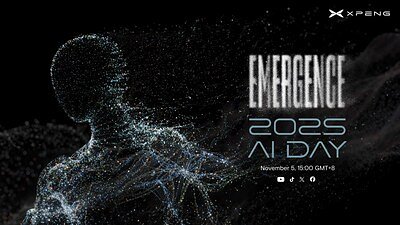
XPeng's AI Push: Can 'Physical AI' Drive China's EV Maker Past the Competition?
XPeng’s ambitious AI Day promises breakthroughs in ‘Physical AI’ and robotaxi tech. But in a crowded EV market, can this strategy deliver a competitive edge and reshape the future of driving?
XPeng's AI Push: Can 'Physical AI' Drive China's EV Maker Past the Competition?
Guangzhou, China – XPeng Inc. is doubling down on artificial intelligence, positioning it as the key differentiator in a rapidly evolving electric vehicle landscape. The Chinese automaker's upcoming AI Day on November 5th, themed “Emergence,” promises a deep dive into the company's advancements in 'Physical AI' and its progress toward fully autonomous robotaxi deployment. But in a fiercely competitive market dominated by industry giants like Tesla, NIO, and BYD, can XPeng's AI-first approach deliver a sustainable competitive advantage?
XPeng’s commitment to AI extends beyond simply adding smart features to its vehicles. It’s a fundamental pillar of the company’s strategy, influencing everything from vehicle design and manufacturing to user experience and autonomous capabilities. “We are not just building electric cars; we are building intelligent robots on wheels,” a source close to the company explained. This philosophy is embodied in XPeng's ‘Physical AI’ – an integrated system combining advanced sensors, powerful computing platforms, and sophisticated algorithms to enable vehicles to perceive, understand, and interact with their environment.
Beyond Software: The Power of Integrated AI
The term 'Physical AI,' while echoing industry buzzwords, highlights XPeng’s focus on bridging the gap between software and hardware. Unlike some competitors who prioritize software-defined features, XPeng is investing heavily in integrating AI directly into the vehicle's physical systems. This includes developing custom sensors, actuators, and control systems optimized for AI processing, leading to faster response times and improved accuracy.
“Many companies are trying to bolt AI onto existing vehicle architectures,” said a leading automotive analyst. “XPeng is taking a more holistic approach, designing its vehicles around AI from the ground up. That gives them a significant potential advantage.”
Robotaxis: A Bold Bet on Autonomous Future
A cornerstone of XPeng’s AI strategy is its ambitious robotaxi program. The company has been conducting public trials in several Chinese cities, gathering valuable data and refining its autonomous driving algorithms. While fully autonomous vehicles remain a distant goal, XPeng is making steady progress.
“The biggest challenge is handling edge cases – unpredictable events that require quick, human-like decision-making,” explained a software engineer familiar with the project. “XPeng is using advanced simulation techniques and machine learning to train its algorithms to handle a wider range of scenarios.”
However, scaling robotaxi deployments faces significant hurdles. Regulatory approvals are a major bottleneck, and public acceptance remains uncertain. China’s government is supportive of autonomous driving innovation, but safety concerns are paramount. XPeng must demonstrate the reliability and safety of its technology to gain regulatory approval for widespread robotaxi operation.
Navigating a Competitive Landscape
XPeng isn't the only automaker investing in AI and autonomous driving. Tesla remains the clear leader in the space, with its Full Self-Driving (FSD) system and extensive data collection capabilities. NIO is also making strides in autonomous driving, partnering with leading technology companies to develop advanced driver assistance systems. BYD, with its strong foothold in the Chinese market, is leveraging its expertise in electric buses and commercial vehicles to accelerate its autonomous driving efforts.
To differentiate itself, XPeng is focusing on several key areas. Its ‘Physical AI’ approach allows for greater integration and control over the entire system. The company is also prioritizing user experience, offering personalized infotainment features and advanced driver assistance systems tailored to the needs of Chinese consumers. Moreover, XPeng is aggressively expanding its charging infrastructure and sales network, making its vehicles more accessible to a wider audience.
“XPeng is playing a smart game,” observed an industry insider. “They are not trying to compete head-to-head with Tesla in every area. They are focusing on their strengths – a deep understanding of the Chinese market, a commitment to innovation, and a willingness to take risks.”
Challenges and Opportunities Ahead
Despite its ambitious plans, XPeng faces several challenges. The company is still relatively small compared to its larger rivals, and it has yet to achieve profitability. Supply chain disruptions and rising raw material costs also pose a threat to its growth.
However, XPeng also has significant opportunities. The Chinese EV market is the largest and fastest-growing in the world, and the demand for electric vehicles is expected to continue to rise. The government is actively promoting the adoption of electric vehicles and supporting the development of autonomous driving technology.
XPeng’s upcoming AI Day will provide a closer look at the company’s progress and its vision for the future. Whether XPeng can successfully navigate the challenges and capitalize on the opportunities remains to be seen. But one thing is clear: the company is determined to push the boundaries of innovation and reshape the future of driving.
